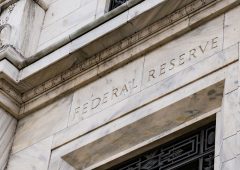Trump Escalates Trade War, Markets on Edge
13.03.2025 21:00 1 min. read Alexander Stefanov
Donald Trump has threatened new tariffs on the EU in response to its planned countermeasures against his steel and aluminum duties.
During a meeting with Ireland’s Prime Minister, he criticized the bloc’s policies and warned of further action.
Canada also hit back, announcing $29.8 billion in tariffs, while its central bank cut interest rates, anticipating economic fallout. The U.S. is now considering restrictions on copper, while the EU’s response could hit $28 billion worth of American exports. Markets fear a deeper trade conflict.
Trump’s tariff policies have alarmed business leaders and lawmakers. Tech executives met with him to raise concerns, but he remained focused on boosting domestic investment. Treasury Secretary Scott Bessent’s remark that the economy needs a “detox” worsened recession fears, sending Wall Street into decline.
ECB President Christine Lagarde warned that U.S. trade policies are fueling instability, citing tariffs as a threat to EU exports. Rising defense spending in Europe could push inflation higher, while the ECB, already grappling with uncertainty, recently cut rates to 2.5%. She stressed the need for transparency in guiding businesses and consumers through volatile conditions.
-
1
Fed’s New Projections Hint at a Slower Easing Cycle Through 2026
19.06.2025 15:00 2 min. read -
2
Trump Targets Fed Over Missed Rate Cut Opportunity
20.06.2025 9:00 1 min. read -
3
UK Inflation Stalls at 3.4%, Spotlight Shifts to BoE’s August Meeting
19.06.2025 9:00 2 min. read -
4
Fed Holds Fire on Rates, Signals Cuts Could Arrive if Jobs Falter
18.06.2025 21:30 1 min. read -
5
U.S. National Debt Surge Could Trigger a Major Crisis, Says Ray Dalio
26.06.2025 10:00 1 min. read
Key U.S. Economic Events to Watch Next Week
After a week of record-setting gains in U.S. markets, investors are shifting focus to a quieter yet crucial stretch of macroeconomic developments.
Robert Kiyosaki Predicts When The Price of Silver Will Explode
Robert Kiyosaki, author of Rich Dad Poor Dad, has issued a bold prediction on silver, calling it the “best asymmetric buy” currently available.
U.S. PCE Inflation Rises for First Time Since February, Fed Rate Cut Likely Delayed
Fresh data on Personal Consumption Expenditures (PCE) — the Federal Reserve’s preferred inflation gauge — shows inflation ticked higher in May, potentially delaying the long-awaited Fed rate cut into September or later.
Trump Targets Powell as Fed Holds Rates: Who Could Replace Him?
Federal Reserve Chair Jerome Powell is once again under fire, this time facing renewed criticism from Donald Trump over the Fed’s decision to hold interest rates steady in June.
-
1
Fed’s New Projections Hint at a Slower Easing Cycle Through 2026
19.06.2025 15:00 2 min. read -
2
Trump Targets Fed Over Missed Rate Cut Opportunity
20.06.2025 9:00 1 min. read -
3
UK Inflation Stalls at 3.4%, Spotlight Shifts to BoE’s August Meeting
19.06.2025 9:00 2 min. read -
4
Fed Holds Fire on Rates, Signals Cuts Could Arrive if Jobs Falter
18.06.2025 21:30 1 min. read -
5
U.S. National Debt Surge Could Trigger a Major Crisis, Says Ray Dalio
26.06.2025 10:00 1 min. read


